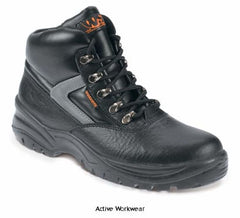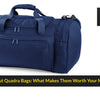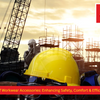How Investing in High-Quality Safety Boots Boosts Productivity on the Job
- by Mike Johnson
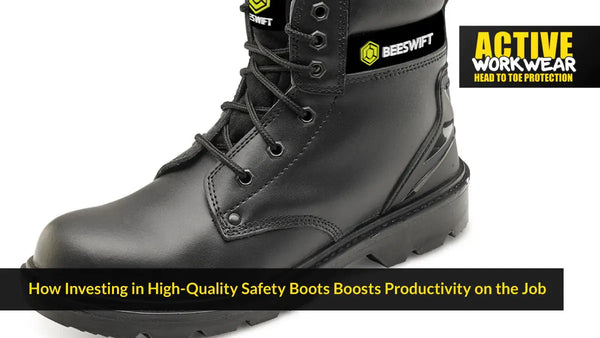
In an environment where employee safety is paramount, the role of safety boots cannot be overstated. These essential pieces of footwear not only safeguard workers from a myriad of hazards but also significantly enhance productivity. The difference between standard and high-quality safety boots can make a profound impact on an organisation's operation and reputation.
This article delves into how investing in superior safety boots can transform a workplace, promoting employee well-being, cost savings, compliance, and accident prevention.
The Significance of Quality in Safety Boots
Safety boots are a critical piece of Personal Protective Equipment (PPE) that shield workers from workplace hazards. However, the quality of these boots determines their effectiveness and the level of protection they offer. High-quality safety boots provide superior protection, enhance worker morale, and improve productivity.
Bolstering Employee Morale
Providing employees with high-grade safety boots sends a clear message about the company's commitment to their health and safety. This gesture not only elevates job satisfaction but also enhances company loyalty, fostering a positive image of the organisation among employees and external stakeholders.
Boosting Confidence and Focus
High-quality safety boots instil a sense of assurance in workers, empowering them to focus on their tasks without worrying about potential hazards. This confidence, coupled with the comfort these boots provide, translates to increased productivity and efficiency.
Reducing Absenteeism
By offering the best level of comfort and protection, high-quality safety boots minimise work-related foot problems and injuries, leading to fewer sick leaves. Consequently, this increases productivity, benefiting the employees and the organisation's profitability.
The Economic Aspect of Quality Safety Boots
While high-quality safety boots may initially have a higher price tag, in the long run, they offer superior value for money. They provide long-lasting protection and offer various other benefits that contribute to cost savings for the company.
Compliance and Testing
The Importance of Proper Maintenance
Making the Right Investment
When choosing safety boots for your workforce, consider the specific requirements of your industry and the potential risks involved. Whether it's steel-toe work boots or non-slip shoes, investing in high-quality footwear can significantly improve your employee's work experience and overall quality of life.
Here are some of the recommended high-quality safety boots:
These are designed to protect your feet from various hazards at the workplace. They are made of black leather with reflective detailing for better visibility. They have a steel toe cap and a steel midsole to prevent injuries from falling or sharp objects. They also have a PU dual-density sole that is resistant to chemicals and oil and provides shock absorption and anti-static properties.
The collar and tongue are padded for comfort and support, and the heel kick makes them easy to take off. These boots are rated S1P for safety and SRA for slip resistance. They are available in sizes 5 to 13 and can withstand a temperature of 200ºC.

These are smooth leather boots with a 6-inch height and a dual-density PU sole. It has a 200 Joule steel toe cap and a steel midsole for protection from impact and penetration.
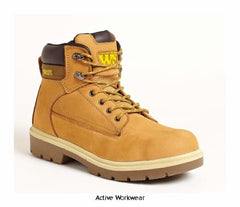
These are wheat nu-buck boots that have a stylish and rugged look. It has a steel toe cap, a steel midsole for safety, and a PU sole resistant to chemicals and oil.
It also has a shock absorption feature and an anti-static feature. The padded collar and tongue provide comfort, and the heel kick region allows easy removal. The boot is rated S1P for safety and SRA for slip resistance. It is available in sizes 3 to 13 and can withstand a temperature of 200ºC.

These are black leather boots that are water-resistant and suitable for wet conditions. They have a steel heel and a steel toe cap for protection and a PU dual-density sole unit resistant to chemicals and oil. They also have a shock absorption sole and an anti-static feature.
The extra-wide size range fits people with a variety of foot sizes, and the padded collar and tongue make them comfortable to wear. The boot is rated S3 for safety and SRA for slip resistance. It is available in sizes 3 to 14 and can withstand a temperature of 200ºC.
In conclusion, investing in high-quality safety boots is a cost-effective strategy that not only safeguards your employees but also enhances their productivity and overall job satisfaction.
By choosing quality over cost, you're investing in the long-term success and well-being of your organisation and its most valuable asset - its people.
"Safety boots are more than just footwear. They are a crucial investment in the safety and productivity of your workforce." - Safety Expert.
What are safety boots used for?
Are safety shoes considered PPE?
High-quality safety boots demonstrate a consistent correlation between cost and performance. Despite their higher price, their superior performance in safety tests and longevity in providing protection make them a wise investment.
Compliance and Testing
High-quality safety boots ensure compliance with safety standards, providing peace of mind to both employers and employees. These boots undergo rigorous testing and come with certifications that attest to their high level of protection.
Safety Boots and Accident Prevention
Safety boots are crucial in preventing workplace accidents. They provide the necessary protection for those working in safety-critical roles. High-quality safety footwear can significantly reduce the number of accidents and injuries, contributing to a safer working environment.
The Importance of Proper Maintenance
To maximise the benefits of high-quality safety boots, it's essential to maintain them properly. Regular cleaning, using protective accessories, and rotating your boots can prolong their lifespan and ensure they continue to provide optimum protection and comfort.
Making the Right Investment
Investing in high-quality safety boots is not just a good business decision but a necessary one. These boots improve employee well-being, save costs, ensure peace of mind, and enhance safety.
When choosing safety boots for your workforce, consider the specific requirements of your industry and the potential risks involved. Whether it's steel-toe work boots or non-slip shoes, investing in high-quality footwear can significantly improve your employee's work experience and overall quality of life.
Here are some of the recommended high-quality safety boots:
1. WORKSITE S1P BLACK SAFETY WORK BOOTS STEEL TOE & MIDSOLE SIZES: 5-13 SS601 SM
These are designed to protect your feet from various hazards at the workplace. They are made of black leather with reflective detailing for better visibility. They have a steel toe cap and a steel midsole to prevent injuries from falling or sharp objects. They also have a PU dual-density sole that is resistant to chemicals and oil and provides shock absorption and anti-static properties.
The collar and tongue are padded for comfort and support, and the heel kick makes them easy to take off. These boots are rated S1P for safety and SRA for slip resistance. They are available in sizes 5 to 13 and can withstand a temperature of 200ºC.
2. BEESWIFT SMOOTH LEATHER 6 EYELET SAFETY BOOT WITH MIDSOLE BLACK S1P SRC - CF2

These are smooth leather boots with a 6-inch height and a dual-density PU sole. It has a 200 Joule steel toe cap and a steel midsole for protection from impact and penetration.
It also has a shock absorber heel, an anti-static feature, and an oil-resistant sole. The leather upper is durable, and the TPU heel support provides stability.
3. WORKSITE S1P NUBUCK SAFETY BOOT STEEL TOE & MIDSOLE UNISEX SIZES 3-13 - SS613-SM

These are wheat nu-buck boots that have a stylish and rugged look. It has a steel toe cap, a steel midsole for safety, and a PU sole resistant to chemicals and oil.
It also has a shock absorption feature and an anti-static feature. The padded collar and tongue provide comfort, and the heel kick region allows easy removal. The boot is rated S1P for safety and SRA for slip resistance. It is available in sizes 3 to 13 and can withstand a temperature of 200ºC.

These are black leather boots that are water-resistant and suitable for wet conditions. They have a steel heel and a steel toe cap for protection and a PU dual-density sole unit resistant to chemicals and oil. They also have a shock absorption sole and an anti-static feature.
The extra-wide size range fits people with a variety of foot sizes, and the padded collar and tongue make them comfortable to wear. The boot is rated S3 for safety and SRA for slip resistance. It is available in sizes 3 to 14 and can withstand a temperature of 200ºC.
In conclusion, investing in high-quality safety boots is a cost-effective strategy that not only safeguards your employees but also enhances their productivity and overall job satisfaction.
By choosing quality over cost, you're investing in the long-term success and well-being of your organisation and its most valuable asset - its people.
To find high-quality safety boots that meet your specific needs, head to our boot finder and let us assist you in making the right choice.
"Safety boots are more than just footwear. They are a crucial investment in the safety and productivity of your workforce." - Safety Expert.
Frequently Asked Questions About Safety Boots:
What are safety boots used for?
Safety boots protect the feet from injuries caused by falling or rolling objects, sharp or piercing objects, electrical hazards, chemical hazards, extreme temperatures, and slippery surfaces. They are also used for preventing fatigue, burns, and infections.
Why is the wearing of safety boots compulsory?
The compulsory wearing of safety boots in the UK is a critical aspect of workplace safety, primarily driven by regulations and the need to protect workers from various hazards. The underlying reasons for this mandate include:
Legal Regulations and PPE Requirements: According to the Personal Protective Equipment at Work Regulations (PPER) 1992, PPE (Personal Protective Equipment) is defined as equipment intended to be worn or held by a person at work, which protects them against risks to health or safety.
Employers are required to provide necessary PPE, including safety boots, free of charge after conducting a risk assessment. PPE is considered the last resort for protection after other controls like elimination, substitution, and engineering controls have been considered.
Protection from Workplace Hazards: Workplaces often expose workers to various hazards that can cause serious injuries to feet. Safety boots are particularly crucial in jobs where there's a risk of heavy objects falling on feet. They are also important in environments involving electricity, heavy equipment, climbing hazards, exposure to chemicals, and slippery surfaces. Safety boots are designed to mitigate these risks effectively.
Prevention of Specific Foot Injuries: Various types of foot injuries can occur in the workplace, such as cuts, broken or severed toes, sprains, electric shocks, punctures from sharp objects, crushed or broken feet (including amputations), and burns from molten metal and chemicals.
Safety boots are essential in preventing these injuries, offering protection tailored to specific workplace risks.
In summary, the compulsory wearing of safety boots in the UK is grounded in legal requirements and the practical need to protect workers from a wide array of potential hazards and injuries in the workplace. Employers are obligated to provide suitable PPE, including safety boots, as a last line of defence against these risks, ensuring a safer working environment.
What is the difference between work boots and safety boots?
Work boots and safety boots are similar in that they both provide protection and comfort for the feet, but they differ in the level and type of protection they offer.
Work boots are general-purpose footwear suitable for various work environments, while safety boots are specialised footwear that meet specific standards and regulations for particular hazards. Work boots may or may not have safety features, such as toe caps or electrical resistance, while safety boots must have these features.
Are safety shoes considered PPE?
Yes, safety shoes are considered personal protective equipment (PPE) for the feet. PPE is any equipment that is worn to minimise exposure to hazards that cause serious workplace injuries and illnesses
What happens when you don't wear safety shoes?
When you don't wear safety shoes, you are exposing your feet to potential injuries and illnesses that can affect your health, productivity, and quality of life. Some of the common foot injuries that can occur when you don't wear safety shoes are fractures, sprains, strains, lacerations, punctures, burns, infections, and amputations.

